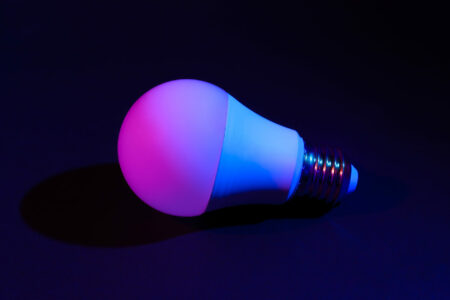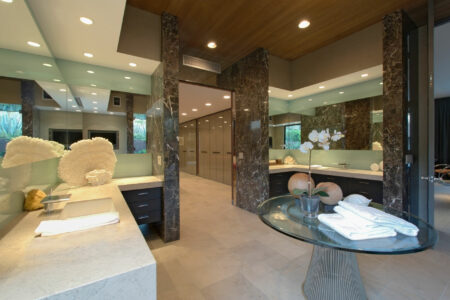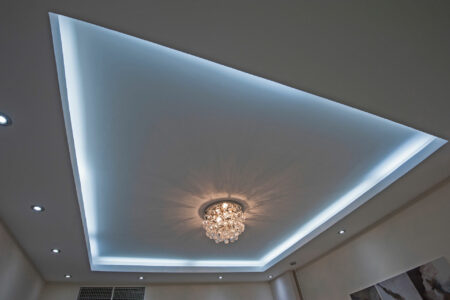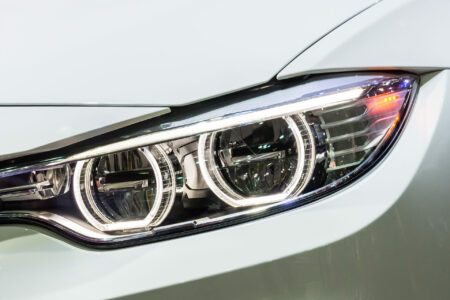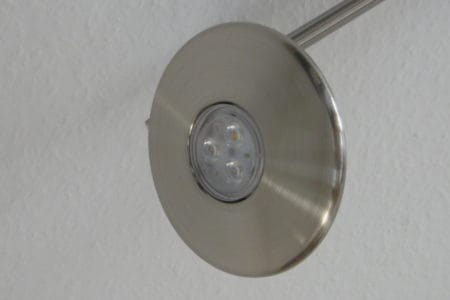In a strict sense the color of an individual LED cannot be changed. Although you will find multi-color LED lights today, what you are seeing is not the individual LED changing it’s color. Light is emitted from the inside of the bulb by multiple diodes of different colors. This is often called a color-changing LED. It’s actually made up of three separate LEDs in one casing.
What is an LED?
LED stands for light-emitting diode. In an LED light, you will find a semiconductor that emits photons when current passes through it. Photons are a form of energy that we see as light.
What gives the LED its color?
When an LED light is lit, we can see a specific color. And this color depends on the level of energy emitted by the semiconductor used. An individual LED can display light in only one color.
Different materials for semiconductors are used in order for the energy level to be controlled. Colored diodes are then created by each of these different semiconductor materials. For a red diode, the semiconductor used is made from aluminum gallium arsenide. Gallium phosphide is the semiconductor material used in green diodes, while the blue diode is the result of using indium gallium nitride.
How does LED light change color?
As we have mentioned earlier, a color-changing LED consists of three separate LEDs in one casing. There is a specific color emitted by each of these diodes – red, green, or blue. And these colors are used because every other color is simply a combination of any of them.
If current is passed through one LED at a specific time, it will appear as a single colored light, either red, green, or blue. Each diode can only produce a single color so when it is powered, it gives off that color.
Other colors can be produced from an LED light by combining the three primary colors and controlling their intensities.
If current is passed through two LEDs at one time, the combined colors can produce another color. So, if the current is applied to the red and blue diodes, it will create a light that is magenta in color. Yellow light is produced if a combination of the red and green diodes is powered. And if the current is passed through the blue and green diodes, it creates a cyan-colored light.
If different levels of current are passed through different diodes, it will create different shades from the main colors. So, if current at 100% brightness is passed through a red diode, the light will be red, but if the brightness is lowered to 50%, then the light produced will be colored pink. Or, if the red is given 100% brightness but the green is given only 50%, then the resulting color will be between red and yellow which is an orange light.
In all, alternating current flow to each of the diodes can result in millions of colors and shades. It is amazing that mixing just three primary colors can achieve this.
If all three diodes are given full current at the same time, then the light it creates is color white.
The switching on or off of each diode is controlled by a microcontroller so that the colors can change. Whatever diode the microcontroller turns on, then that will be the color of the light coming from the lamp.
To quantify the intensity of each diode, a color code is used. There is a numerical value given to each diode. These numbers are between 0 and 255 where 255 is 100% brightness. So, using our example above, where we had the combination of 100% red and 50% green to form the color orange, the color code would be 255, 128, 0. In percentage form this will be 100% (red), 50% (green), and 0% (blue).
It may not be possible for you to be able to customize the colors of your LED unless you can access the microcontroller. However, in recent years, the smart LED became popular. With this technology, you can now control the color of your LED lights. You just need a smartphone app or through remote control.
You can also control the full-color tuning of your LED bulbs by connecting to a local area network. This gives your computer or device the necessary software to be able to change your LED colors. You will then have total control of the color that you want for your lamps and lighting fixtures.
So, with this technological advancement, the colors of your LED light can be changed. There are many uses for colored lights. It is not only used in the theaters for its decorative effects. It can also be used to indicate something when it is not sufficient to only display the on and off option, but there is limited space. There are even studies that show the there are colors of light that can be beneficial or detrimental to sleep.
How can the color temperature of an LED light be changed?
When we speak of color, we are referring to the color of light that is emitted by the diode. This can be any color. However, color temperature refers to the shade emitted by white light. White lights can emit warm or cool visual effects which are measured in degrees Kelvin.
Changing the color temperature of an LED light is not easy to do. The reason for this is that when LEDs are manufactured, their color temperature is fixed. It has a specific Kelvin color which cannot be changed.
But due to innovation, LED fixtures can now have changing color temperatures. These fixtures now come with two sets of LED chips. You can then alternate between cool and warm color temperatures.
This is great since most customers find it difficult to decide which color temperature lamp to buy. So, if you can easily switch from 3000K to 5000K with a simple switch, then the problem is solved. Now, this has been made possible by technological advancements in LED.
What is white color tuning?
White color tuning allows you to change the color temperature of a given fixture manually. This is also called LED color preference.
In general, you will find a dip switch in the fixture. This switch will allow you to change the color temperature from 2700K or 3000K to up to 5000K. In this technology, you will be able to control the color temperature and light output independently.
Now the problem of what color temperature lamp to buy is solved. If you are not sure what color temperature to get, you don’t have to worry. You can simply change it as you want after buying it.
This is also beneficial to those who manufacture these lamps. Now, they only have to manufacture one unit instead of more. With this flexibility, the possibility of having the fixture returned is decreased.
Are there other ways to change the LED light color?
Although remote-controlled LED lights are great for your home, it is quite expensive compared to buying a single-colored lamp. But you can easily change the color of an LED light with some DIY methods.
What is LED light housing?
The housing or casing of LED lights is made of epoxy resin. This material is translucent and the reason why the light comes out of it. LED translucency can be diffused or water cleared.
Diffused LEDs are cloudy in looks and it allows the light to spread out evenly in your home. On the other hand, water clear LEDs are very transparent and made of plastic. This gives a brighter light than the diffused LED. The transparent material used does not absorb or disperse light.
How do you change the LED light color in a fun way?
If your home only uses a white LED, a fun way of changing its color is by using any thin paper or tissue. You need to cut the paper in a size that can easily wrap your LED bulb from the outside.
Before wrapping the bulb, use color markers to color the paper. Then tape them securely to the bulb. If you turn on the bulb, you will now get a different color of light. If you want another color, then you simply change the paper with another color.
Another method of changing the color of your LED bulb is by coloring the bulb directly. What you need to do first is to sand your bulb until it becomes cloudy. Then get rid of the sanding dust by wiping the bulb lightly.
Use a marker to shade the whole bulb. You should not allow spots where white light can escape when the light is turned on. Dry the colors. You can put another color coating is you want your LED to glow nicely. You will have a more permanent color than the first method. You are coloring the bulb itself.
Conclusion
Because of technological innovation, virtually every color in the visible light spectrum can now light your home. Although you may not fully understand how these colored lights work, one thing you know is that now, you can have more realistic, vibrant colors in your artificial lights.
It is not really important to understand how these colored lights work. But it is enough to know that they can provide us with energy-efficient, eco-friendly light that is far superior to any other in the market today.

